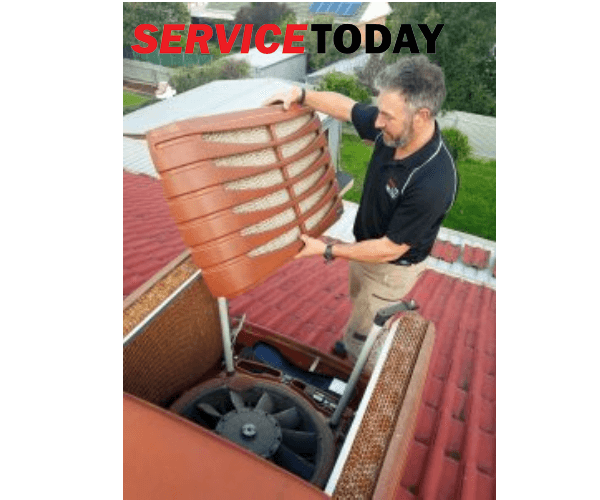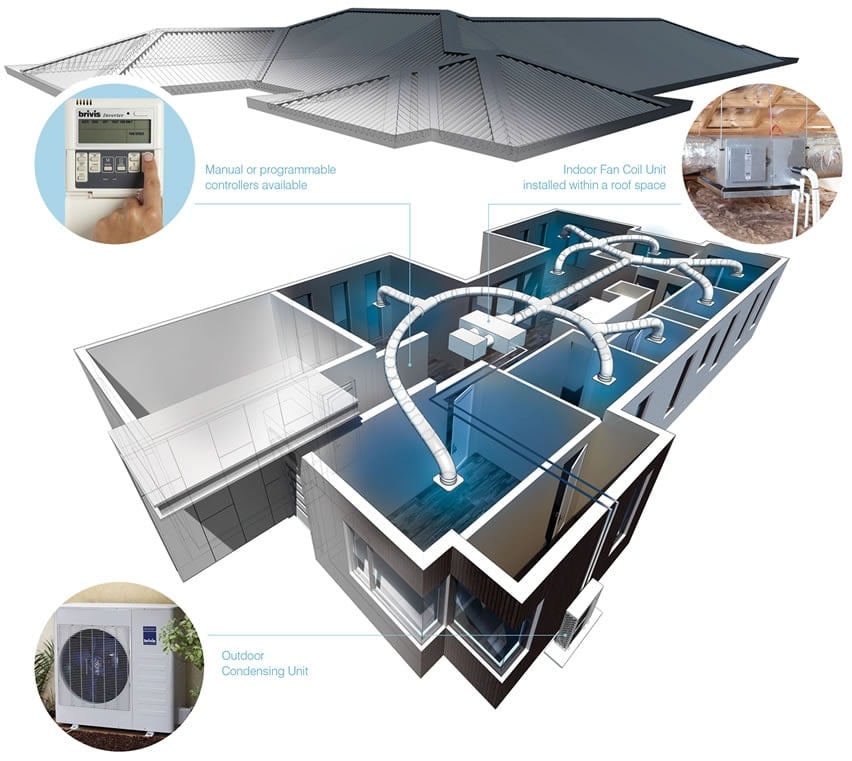Around this time of year, our thoughts begin to turn to the warm and long summer days ahead. But is your home prepared for the blistering heat of another Australian summer? Each household has their own individual cooling needs, and an air conditioning system that best suits one property may not be the most efficient for another. Selecting an air conditioner for your home is no easy task, so we have outlined some of the most popular options on the market to assist with your decision.
Types of Air Conditioning Systems for Your Home
Split System Air Conditioners
Split system air conditioners are comprised of two units: an outdoor compressor unit and an indoor evaporator unit, generally mounted on the walls in a room, and connected by insulated tubes. Warm air is drawn into the system and passed over evaporator coils, cooling the air before it is blown into the room to circulate. The indoor component of a split system air conditioner should be placed up high and in a central location within the desired space, to allow for effective and balanced airflow. A licensed heating and cooling technician can offer expert advice on the ideal location to install any unit in your home.
These split systems are popular because they are quiet to run, as well as effective in cooling individual and compact areas of the home. They are an economical option if you only require a specific room in the house to be cooled.
Advantages of Split System Air Conditioners:
- Quiet operation
- Effective cooling for individual rooms/spaces
- Switch between heating and cooling functions
- Remote operated
- Most models feature a timer, allowing you to set the unit to switch on and off automatically
Multi Split Air Conditioner Systems
If there are multiple rooms to cool in a larger property, but you don’t fancy the idea of having multiple large outdoor units bulking up the side of your house; the solution could be a multi split system. This option allows a property to have multiple indoor split system units installed, connected by piping, to cool a number of rooms with only one outdoor compressor.
Advantages of Multi Split System Air Conditioners:
- Only one outdoor unit required, can connect to up to 5 different indoor units
- Separate controls allow you to independently set the temperature in each room
- Great alternative to ducted systems when space is limited
Window/Wall Air Conditioner Systems
The popularity of these systems has been replaced in modern times by the more efficient split systems – but wall or window mounted air conditioners were once a common choice for temperature control in small rooms and spaces, sufficiently cooling rooms up to 50 square metres. These units tend to be quite noisy, but have the advantage of being easily mounted to a window without the need for separate units; they contain the compressor, condenser, coils and evaporator all in one single unit. Wall units similarly fit through a hole made in the wall of a room. Whilst these air conditioner systems have a generally lower upfront cost, split or ducted systems prove to be the more economical and efficient choice these days.
Advantages of Window/Wall Air Conditioner Systems:
- Reasonably low cost to purchase and operate
- Effective for cooling single rooms and small areas
- Some models are dual-functional, providing both heating and cooling
Ducted Air Conditioner Systems
Designed to control the temperature of an entire house or office, ducted air conditioning works similarly to a split system – comprising of an outdoor unit connected to an indoor unit. However, the main difference lies in the fact that conditioned air is blown through vents into each room, via insulated duct pipes, with the indoor component sitting visibly hidden in the roof space or under the floor. A control panel allows the option to set the temperature for multiple zones in the house, simultaneously.
In many situations, a ducted air conditioning system can be the most effective – despite the high upfront costs. But like any system, individual requirements and circumstances need to be considered first; as a whole-house ducted cooling system would not be beneficial if only a single room was required to be cooled.
Advantages of Ducted Air Conditioner Systems:
- Control indoor temperature throughout various zones in a large home
- Less visually intrusive than split systems – only the control panel and vents are visible inside the rooms
- One cooling solution for the entire home
- Dependent on individual circumstances, can be more economical than installing and running several split system units
Evaporative Cooling Systems
Evaporative cooling is an alternative modern technology that uses fresh air from outside to cool your home, through the evaporation of water. A cooling unit generally placed on the roof of the house draws in hot, dry air and filters it across wet pads or quilts, which cools the air. A fan then pushes this air into the rooms of the house through a duct system, while stale air is forced back outdoors through windows and/or doors by the cool and fresh air replacing it.
Advantages of Evaporative Cooling Systems:
- Energy efficient, using less power than traditional air conditioning systems and helping to reduce energy costs
- Maintain a cool, constant temperature throughout the entire home
- A great alternative for asthma and hay fever sufferers – these systems use moisture to cool the air so they won’t dry your skin, nose or eyes.
- Quiet (often silent) to run
Choosing the Correct Capacity
Once you’ve decided on the type of air conditioner, the next step is to choose the optimal capacity for your home and requirements. Heating and cooling system capacities are rated in kilowatts (kW); the most efficient air conditioner for your space will be one with equal or slightly greater capacity for the room or area it is focusing on.
Apart from the size of the house or space, there are other factors that should to be taken into account when selecting the correct capacity. These include: amount of insulation, lighting, ducting, windows, skylights, curtains, people living in the house, foundation of the property and local climate, as well as several other factors.
Running Costs Of Air Conditioning
Heating and cooling accounts for approximately 40% of household energy use in Australia. For this reason alone, if you are considering organising air conditioning installation, it is important to ensure optimal energy efficiency in your home – to help relieve the pressure of running costs. Several steps can be taken to achieve energy efficiency:
- Choose the correct capacity model of air conditioner for the space.
- Take note of the energy star ratings – models with more stars are more efficient and will use less power.
- Make your home energy efficient – this includes sealing any draughts, installing blinds to block direct sun, closing doors to rooms you do not require and installing adequate insulation, just to name a few.
- Regular maintenance of your air conditioner system including professional jet cleaning will remove any built-up contaminants, extend the life of the system and lower power consumption by increasing airflow and cooling performance.
If you are considering installing or upgrading an air conditioning system in time for summer, give the heating and cooling experts at Service Today a call. Our technicians can advise you on the most efficient system to meet your specific requirements – taking into consideration your individual circumstances, to ensure you find the optimal system for your home. We also offer professional maintenance, jet cleaning and duct cleaning services, to ensure your system continues to run flawlessly and efficiently. For more details call on 1300 859 383 today!




